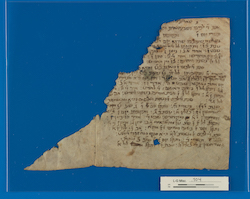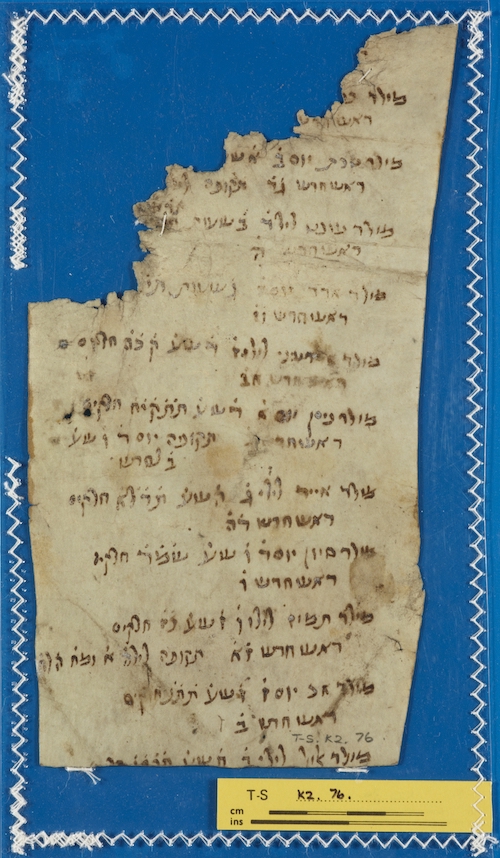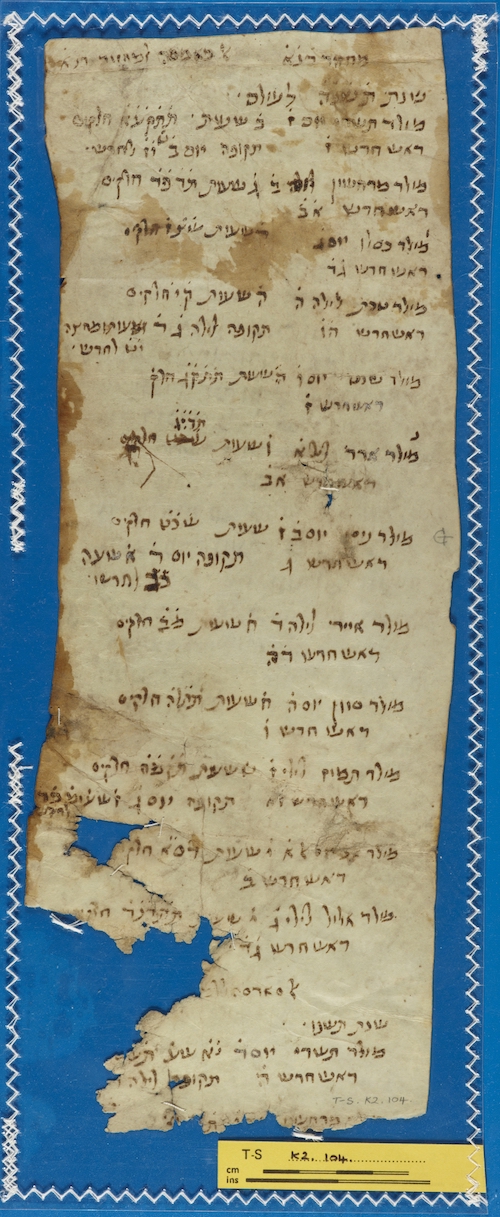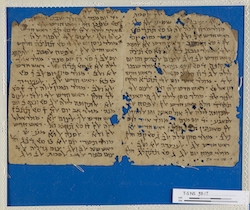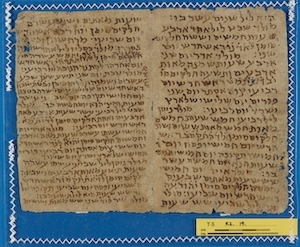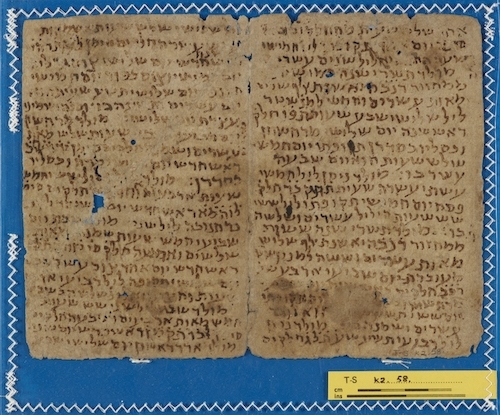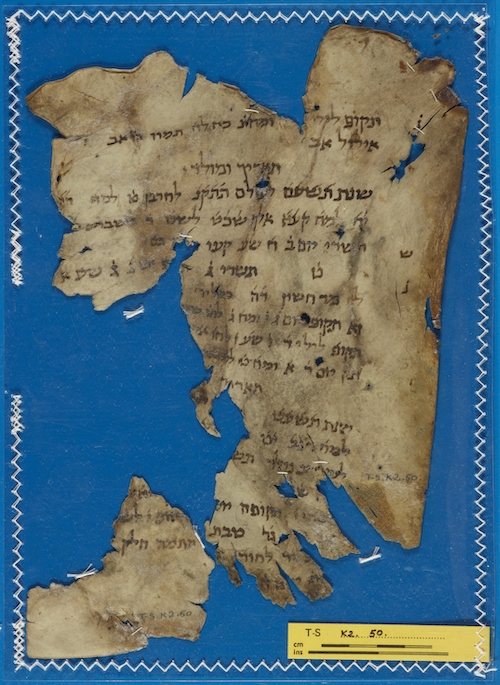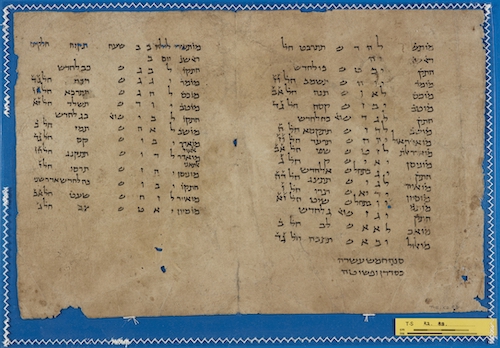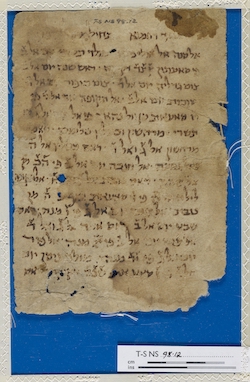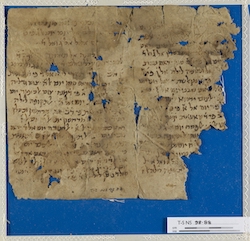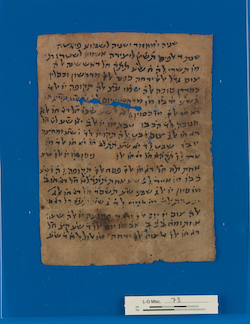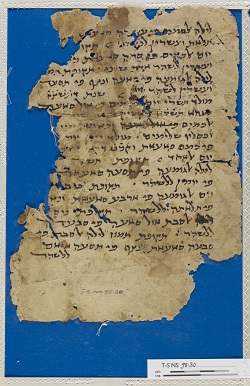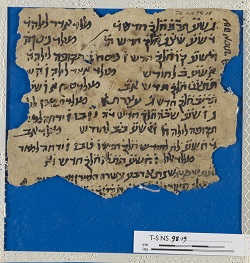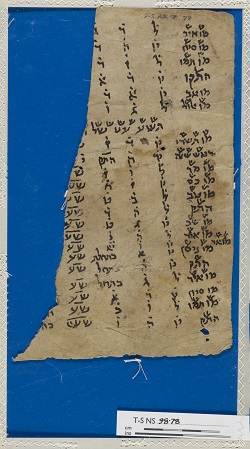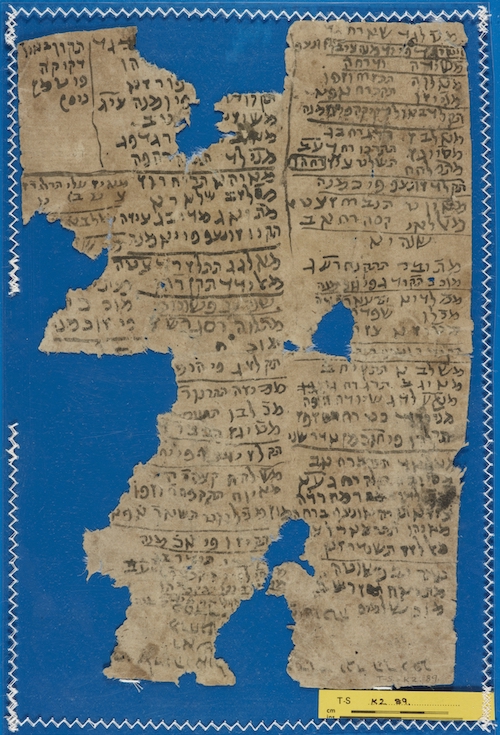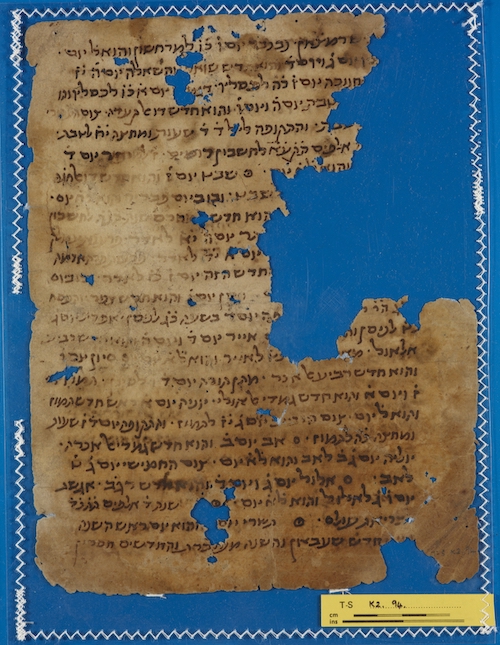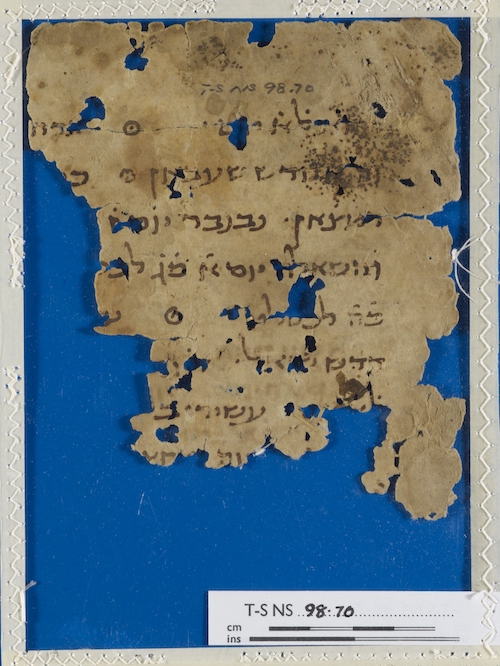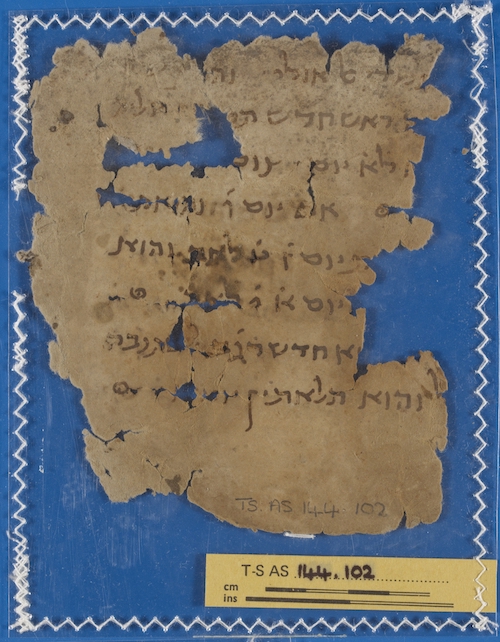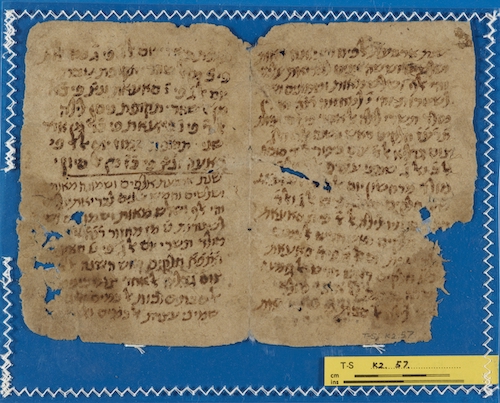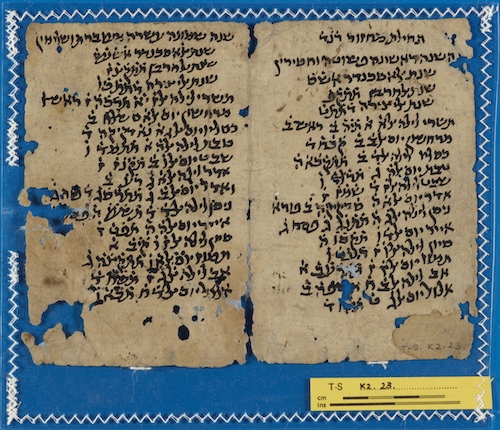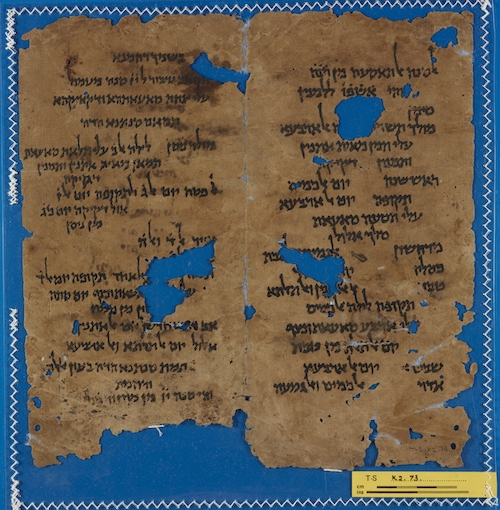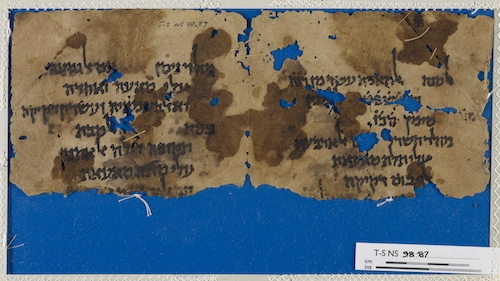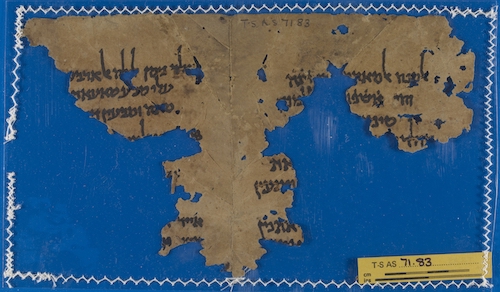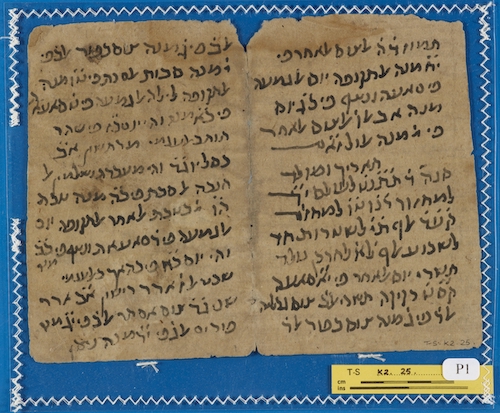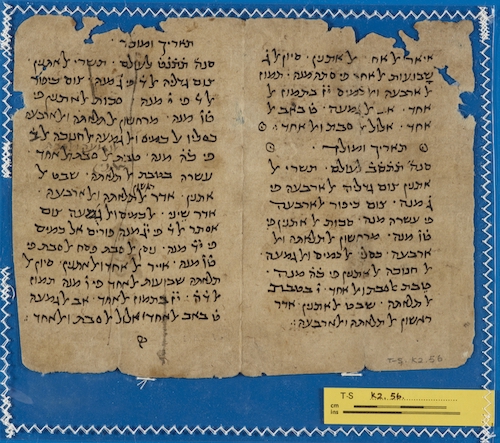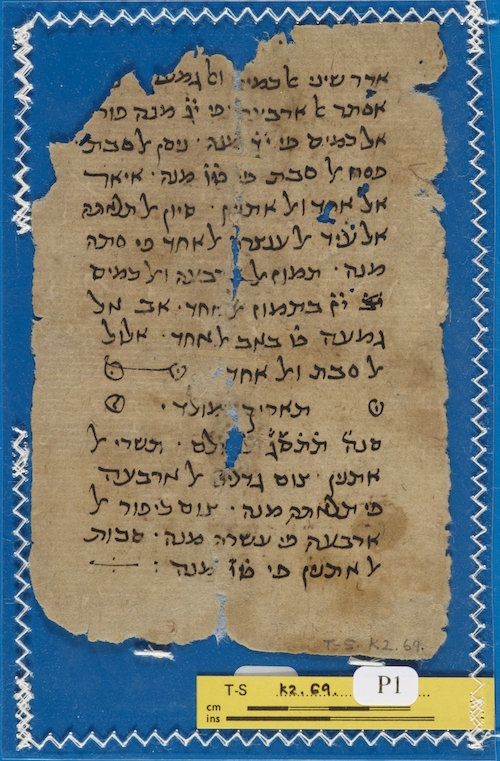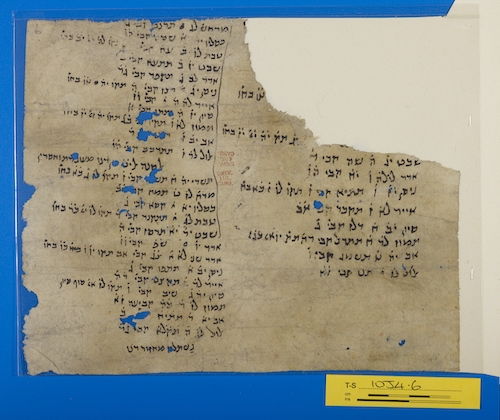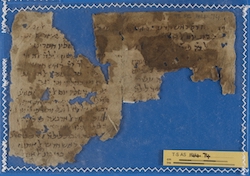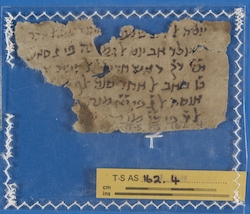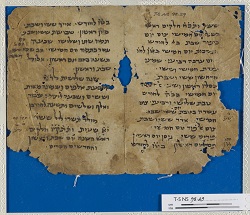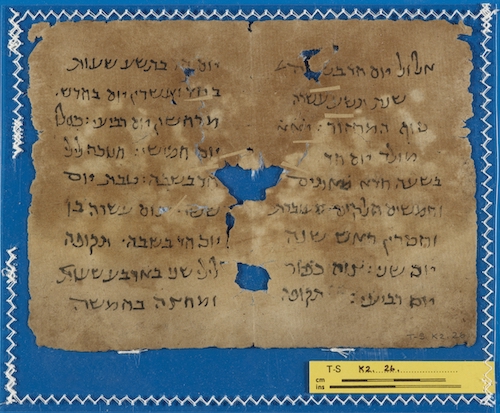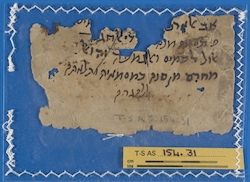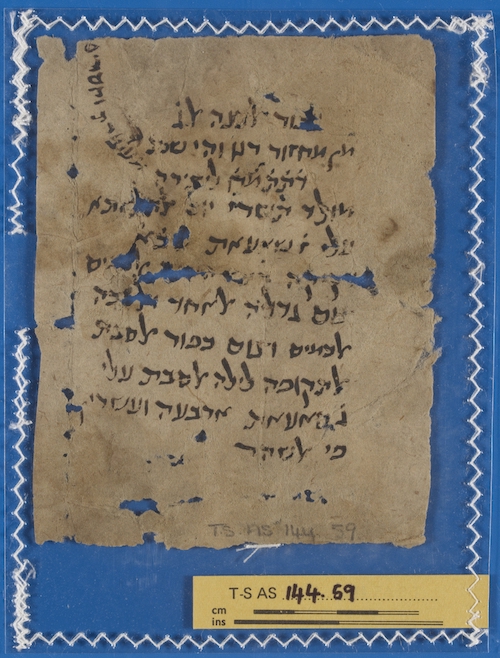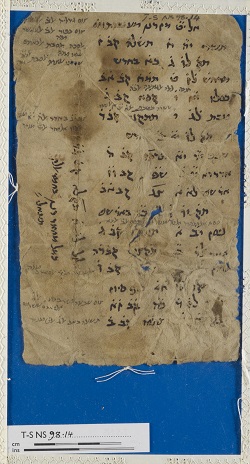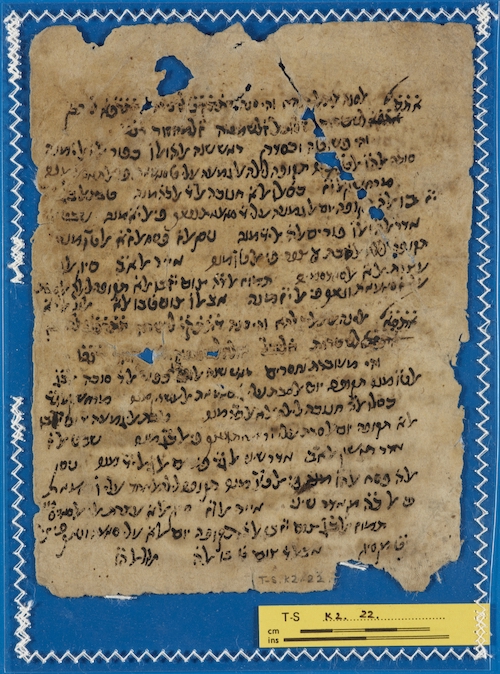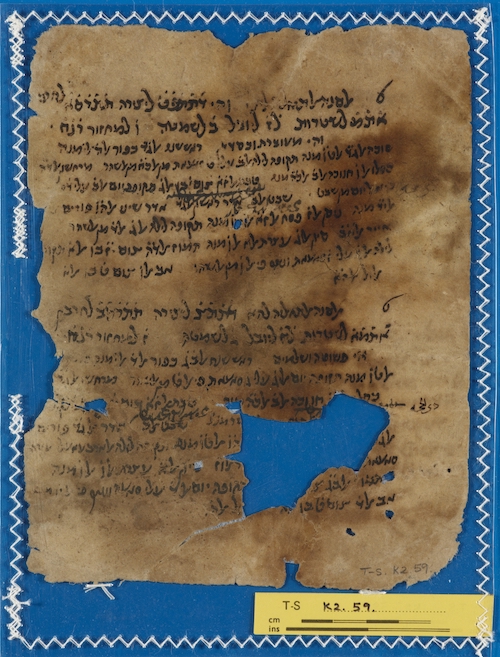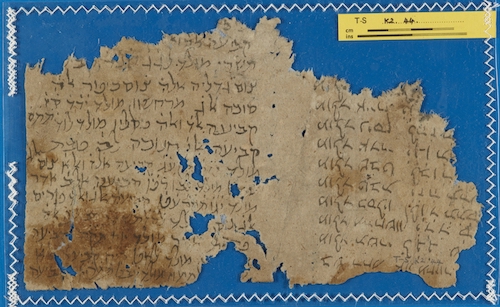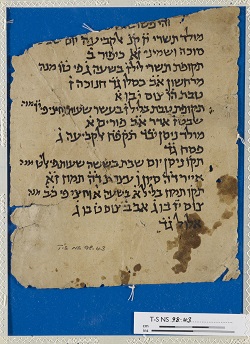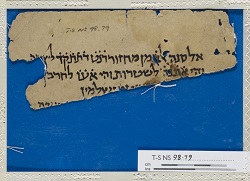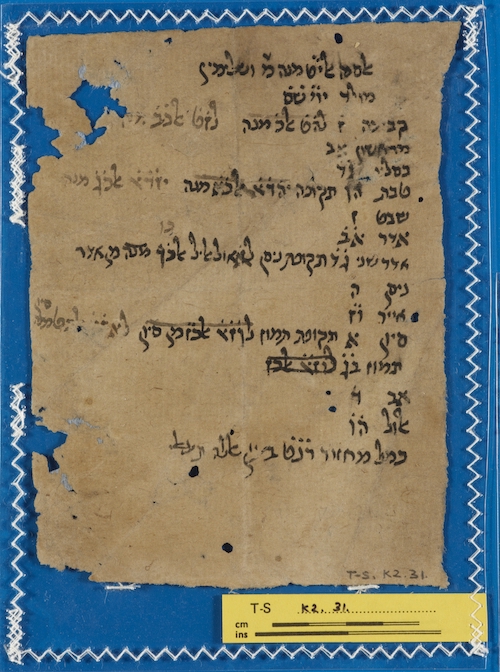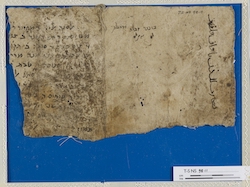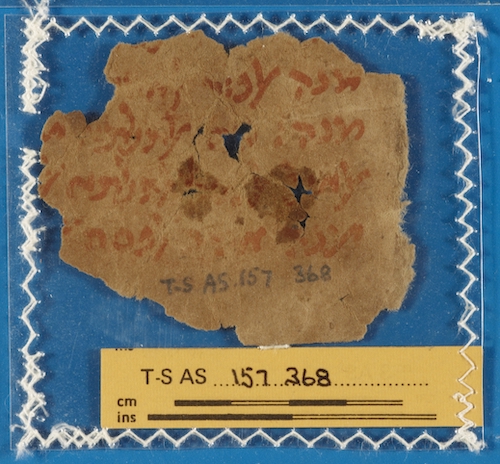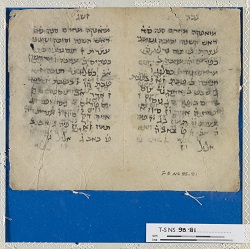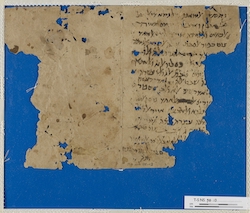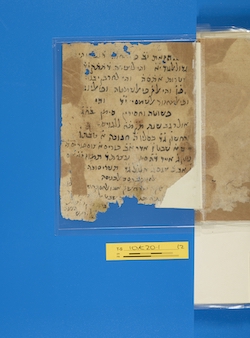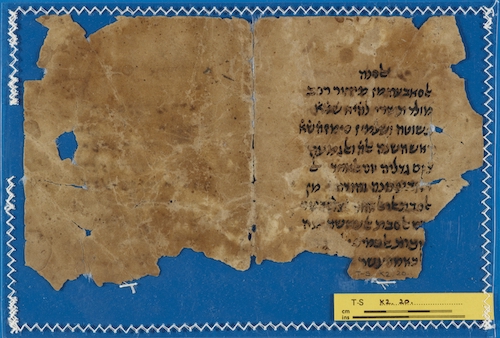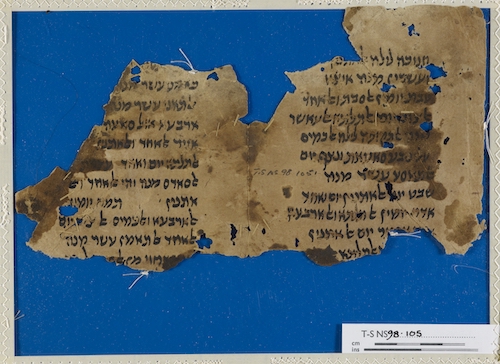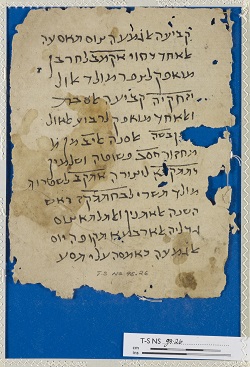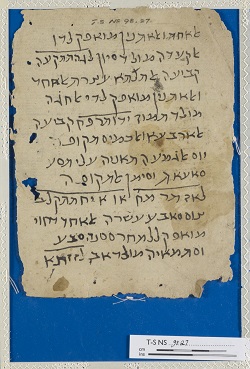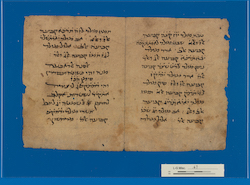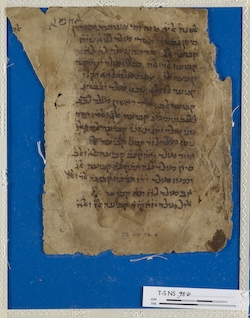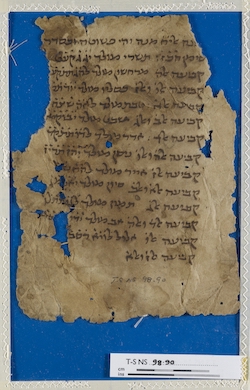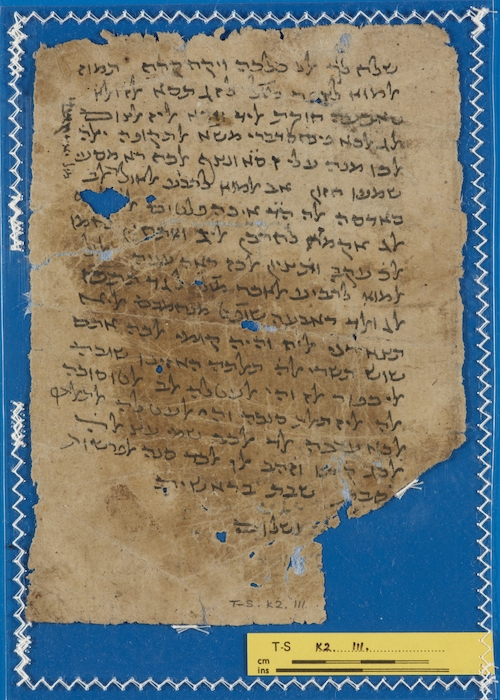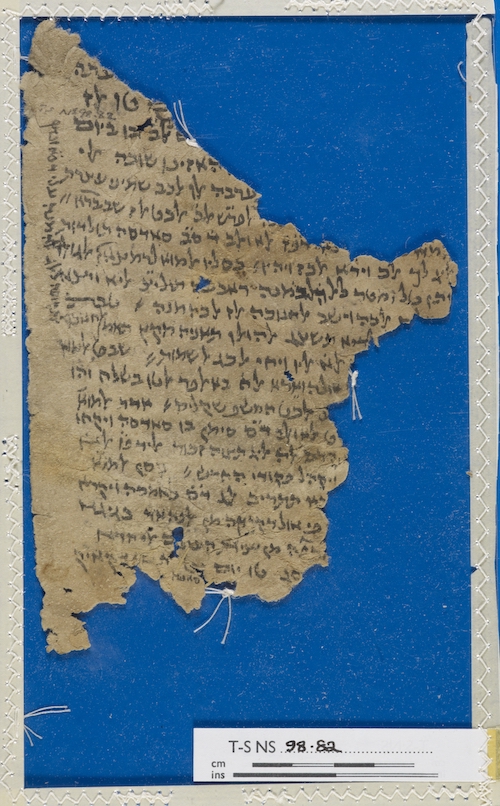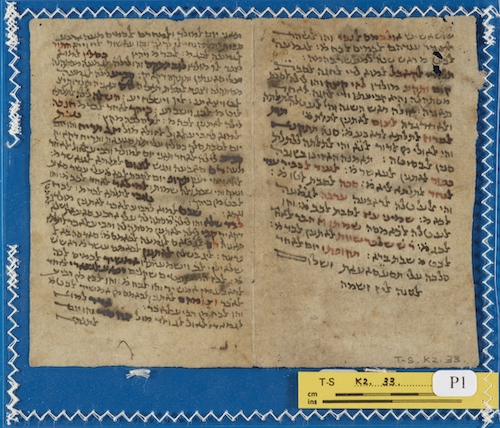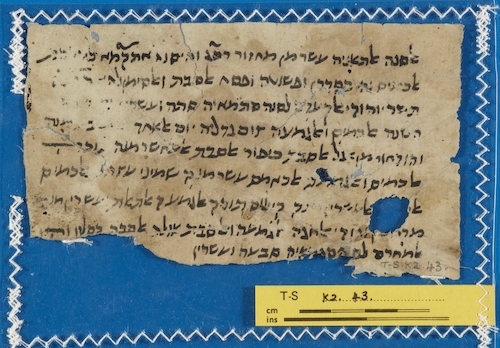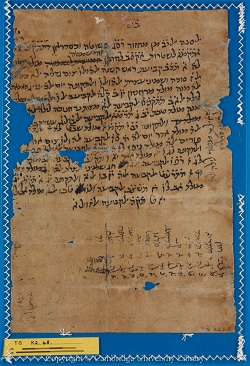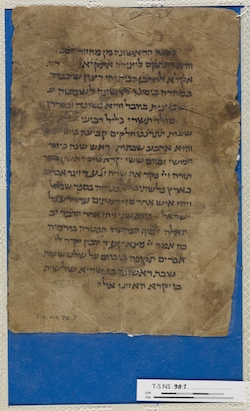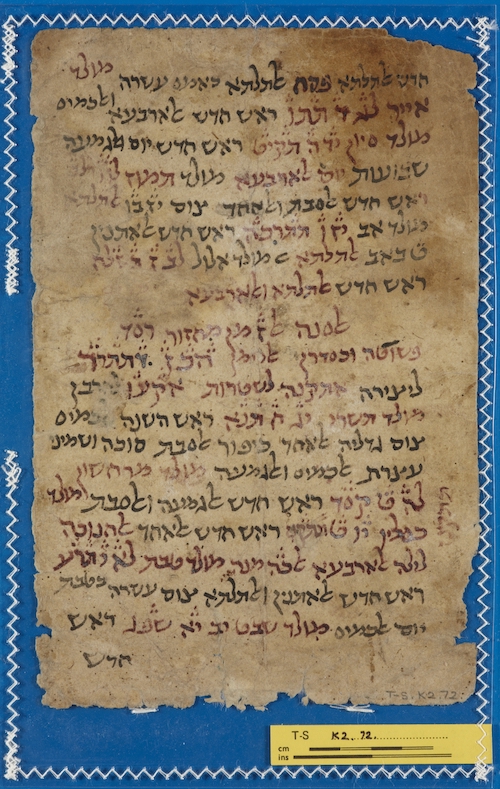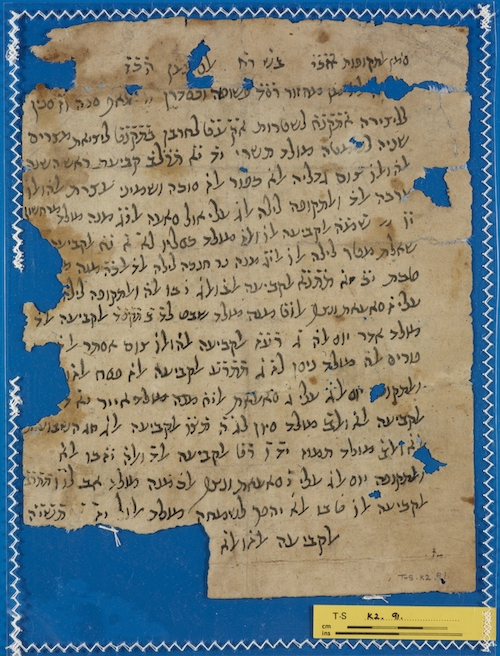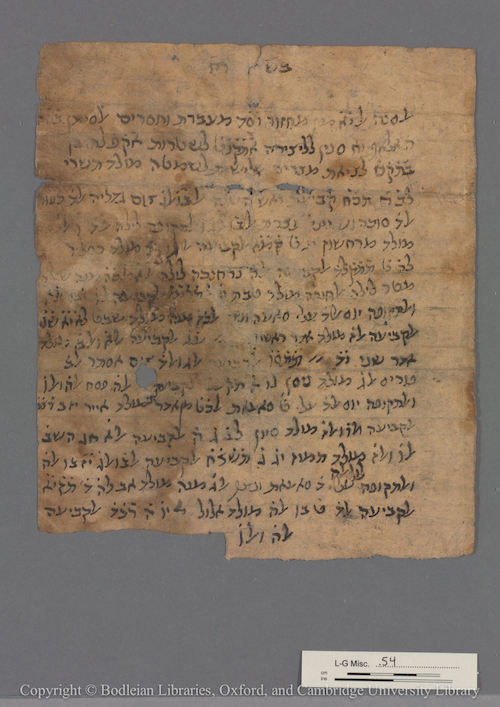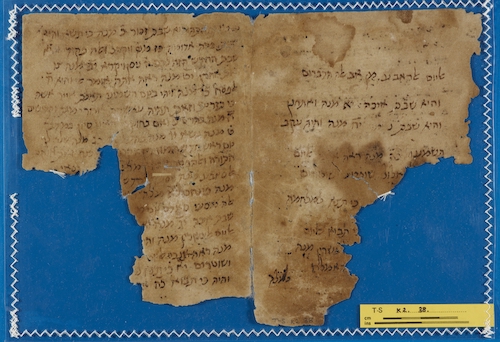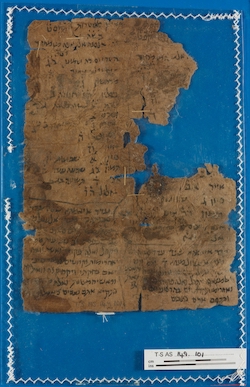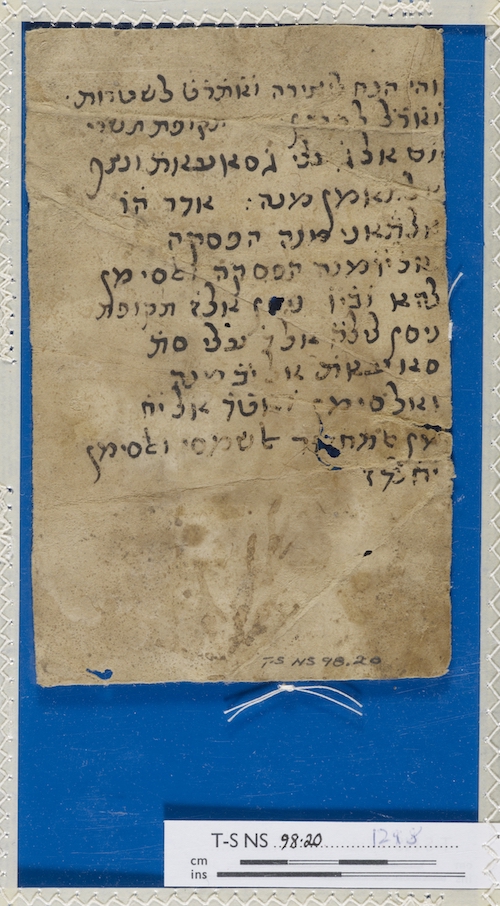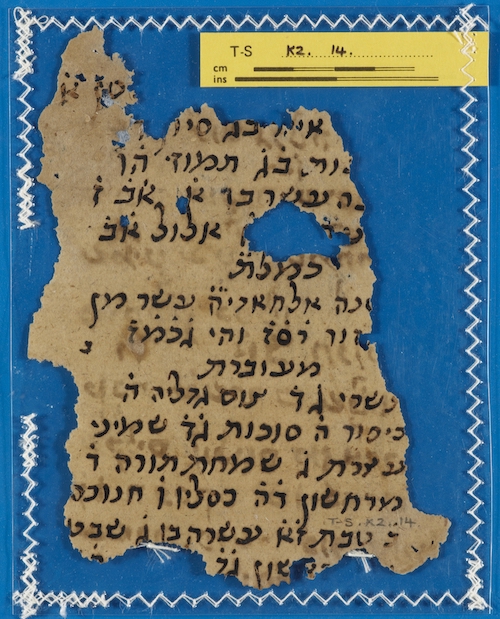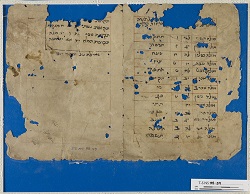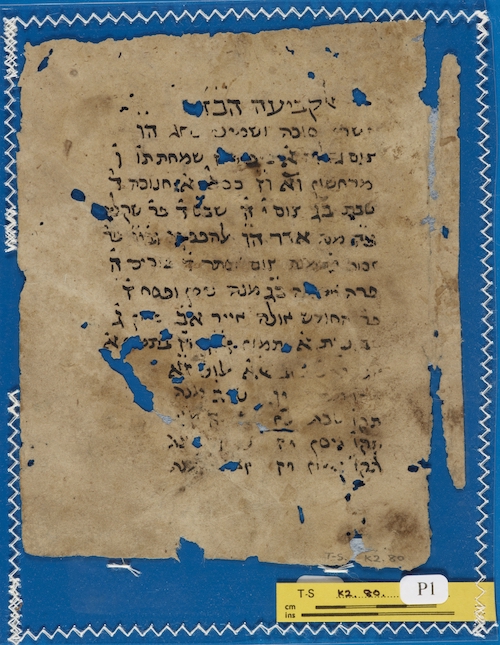Calendar Fragments as a Tool for Palaeography
The objective of this project, funded by the British Academy, was to assemble, date and present on a timeline a corpus of datable fragments on the Jewish calendar, to serve as a tool for paleography. While calendar fragments are rarely explicity dated, they can usually be assigned to a relatively short period of time, and can thus be added to the corpus of datable material, allowing us to use their script for palaeographic comparison. Dr Nadia Vidro assembled and analysed this corpus over a two-year project, 2018–20.
The Cairo Genizah has preserved a wealth of calendrical texts, including treatises on the Jewish calendar, calendar polemics between various religious groups, auxiliary calculations, and actual calendars themselves. Due to the lack of repetition in the calculated Jewish calendar, actual calendar booklets are only useful for the years covered by them. Ephemeral by nature, they can be a small, but useful resource for palaeographic data.
The timeline below is populated with medieval Jewish calendar booklets preserved in the Cambridge Cairo Genizah collections, with a note where these join to fragments in other Genizah collections. Each booklet is represented by its surviving fragments, with information on the covered years, the estimated dating, the employed Eras, and languages. The booklets are ordered chronologically, by the estimated starting cycle of the calendar. You can read more about the project, our corpus and the methodology for dating calendar booklets here and watch a presentation about the project at the bottom of Futher Project information page. A brief description of the attested Eras is here.
Click on the images below to view the fragment and its full description in Cambridge Digital Library (where available).
The Calendars
Use the links below to quickly navigate in the calendar timeline
950 CE
L-G Misc. 104
Estimated dating: mid–third quarter 10th c. (see comment)
Estimated starting cycle of the calendar: 249 (952/3–970/71 CE)
Dates covered: 967/8–970/71 CE. 19-year cycles covered: 249
Material: Parchment
Language: Hebrew
Eras used: Creation
Comment: Year 967/8 CE appears to have been the first year of the calendar. At the top of the page there is the heading ‘The remainder of the 19-year cycle’. The preceding page (verso, left) is blank, and it presumably was the cover page of the booklet.
T-S K2.76r; T-S K2.104r
Estimated dating: second half 10th c. – early 11th c.
Estimated starting cycle of the calendar: 249–251 (952/3–1008/9 CE)
Dates covered: 994/5–995/6 CE. 19-year cycles: 251
Era used: Creation
Language: Hebrew; Judaeo-Arabic
Material: Parchment
Comment: A piyyuṭ by the 10th-c. liturgical poet Solomon ha-Bavli is copied on verso.
T-S NS 98.17, T-S AS 144.191, T-S AS 144.192, ENA 3826.6
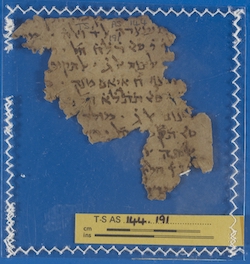
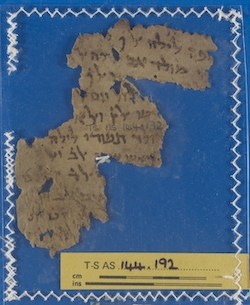
Estimated dating: second half 10th c.
Estimated starting cycle of the calendar: 249–251 (952/3–1008/9 CE)
Dates covered: 995/6–996/7 CE, 998/999–1000/1 CE, 1002/3–1004/5 CE 19-year cycles covered: 251
Material: Paper
Language: Judaeo-Arabic
T-S K2.19; T-S K2.58
Estimated dating: last quarter 10th c. – early 11th c.
Estimated starting cycle of the calendar: 250–251 (971/2–1008/9 CE)
Dates covered: 1006/7–1007/8, 1009/10–1014/5 CE. 19-year cycles: 251–252
Era used: Seleucid
Language: Hebrew
Material: Paper
T-S K2.50
Estimated dating: last quarter 10th c. – first quarter 11th c.
Estimated starting cycle of the calendar: 250–252 (971/2–1027/8 CE)
Dates covered: 1015/6–1018/9 CE. 19-year cycles: 252
Eras used: Creation, Destruction of the Second Temple, Seleucid
Language: Hebrew
Material: Parchment
T-S K2.83
Estimated dating: last quarter 10th c. – first quarter 11th c.
Estimated starting cycle of the calendar: 250–252 (971/2–1027/8 CE)
Dates covered: 1021/2–1022/3, 1027/8 CE. 19-year cycles: 252
Language: Judaeo-Arabic
Material: Paper
T-S NS 98.12, T-S NS 98.88
Estimated dating: end 10th c.–early 11th c. (see comment)
Estimated starting cycle of the calendar: 251 (990/91–1008/9 CE)
Dates covered: 990/91–992/3 CE. 19-year cycles covered: 251
Material: Paper
Language: Judaeo-Arabic
Eras used: Creation, Seleucid, Destruction of the Second Temple
Comment: The calendar may have started in 990/91 CE, the first year of the 19-year cycle 251. The calendar for this years starts with an invocation (T-S NS 98.12 recto), which is not found on other pages. The previous page (T-S NS 98.12 verso) is blank, suggesting that this was the cover page of the calendar booklet. The calendar may not have continued beyong the three years covered in the fragments.
L-G Misc. 73
Estimated dating: last quarter 10th c.–first quarter 11th c.
Estimated starting cycle of the calendar: 251–253 (990/91–1046/7 CE)
Dates covered: 1029/30–1030/31 CE. 19-year cycles covered: 253
Material: Paper
Language: Hebrew
Eras used: Creation, Seleucid, Destruction of the Second Temple
T-S NS 98.30
Estimated dating: end 10th c.–first half 11th c. (see comment)
Estimated starting cycle of the calendar: 251–253 (990/91–1046/7 CE)
Dates covered: 1034/5–1036/7 CE 19-year cycles covered: 253
Material: Paper
Language: Judaeo-Arabic
Eras used: Creation
Scribe, period and place of activity if known: Hillel he-Ḥaver b. Yešuʿa the cantor, active in Tiberias in the first half-mid 11th c.
Location if known or can be estimated: Palestine
Comment: Documents associated with Hillel he-Ḥaver b. Yešuʿa are datable between 1025–1050 CE.
T-S NS 98.19
Estimated dating: end 10th c.–first half 11th c.
Estimated starting cycle of the calendar: 251–253 (990/91–1046/7 CE)
Dates covered: 1040/41–1041/42 CE 19-year cycles covered: 253
Material: Paper
Language: Hebrew
T-S NS 98.78
Estimated dating: end 10th c.–first half 11th c.
Estimated starting cycle of the calendar: 251–253 (990/91–1046/7 CE)
Dates covered: 1044/5–1046/7 CE 19-year cycles covered: 253
Material: Paper
Language: Hebrew
1000 CE
T-S NS 324.32
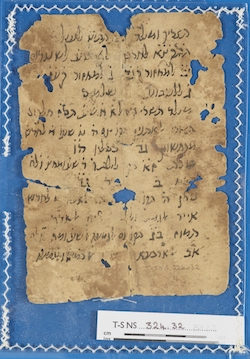
Estimated dating: first half–mid 11th c.
Estimated starting cycle of the calendar: 252–254 (1009/10–1065/6 CE)
Dates covered: 1057/8–1058/9 CE 19-year cycles covered: 254
Eras used: Creation, Destruction of the Second Temple, Seleucid
Material: Paper
Language: Judaeo-Arabic
T-S K2.89r
Estimated dating: first half–mid. 11th c.
Estimated starting cycle of the calendar: 252–254 (1009/10–1065/6 CE)
Dates covered: 1056/7–1059/60 CE. 19-year cycles: 254
Language: Hebrew
Material: Paper
T-S K2.94; T-S NS 98.70; T-S AS 144.102
Estimated dating: first half–mid. 11th c.
Estimated starting cycle of the calendar: 252–254 (1009/10–1065/6 CE)
Dates covered: 1057/8, 1061/2–1063/4 CE. 19-year cycles: 254
Eras used: Creation, Destruction of the Second Temple, Hijra, Byzantine
Language: Hebrew
Material: Paper
T-S K2.57
Estimated dating: second – fourth quarter 11th c.
Estimated starting cycle of the calendar: 253–255 (1028/9–1084/5 CE)
Dates covered: 1073/4–1075/6 CE. 19-year cycles: 255
Eras used: Creation, Seleucid
Language: Judaeo-Arabic; Hebrew
Material: Paper
Mosseri III 254.1
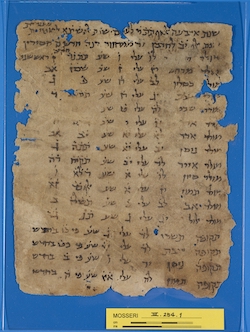
Estimated dating: second–fourth quarter 11th c.
Estimated starting cycle of the calendar: 253–255 (1028/9–1084/5 CE)
Dates covered: 1079/80–1080/81 CE. 19-year cycles covered: 255
Material: Paper
Language: Judaeo-Arabic
Eras used: Creation, Seleucid, Destruction of the Second Temple
T-S K2.23
Estimated dating: mid 11th c. (see comment)
Estimated starting cycle of the calendar: 254 (1048/9–1066/7 CE)
Dates covered: 1048/9, 1065/6–1066/7 CE. 19-year cycles: 254
Eras used: Creation, Seleucid, Destruction of the Second Temple
Language: Hebrew
Material: Paper
Location if known or can be estimated: Babylonia? (see comment)
Comment: It is likely that the calendar started in 1048/9 CE. The fragment is the outer bifolio of a quire and its first page (now verso, left) is empty, suggesting that it is the cover page of the calendar booklet. This makes the year 1048/9 CE, on the following page, the first year covered by the calendar. 19-year cycles in the fragment are counted in the Babylonian way, beginning from what we normally think of as the second year of the cycle.
T-S Ar.29.120
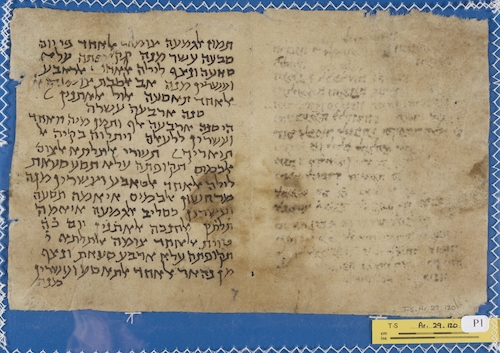
Estimated dating: mid 11th c.
Estimated starting cycle of the calendar: 254 (1047/8–1065/6 CE)
Dates covered: 1052/3–1065/6 CE. 19-year cycles: 254
Eras used: Creation, Seleucid, Destruction of the Second Temple, Hijra
Language: Judaeo-Arabic
Material: Paper
Scribe: Abraham b. Menaḥem
Comment: The starting date of the calendar is explicitly given on T-S Ar.29.120 P5 recto, right, as 1052/3 CE.
T-S K2.73; T-S NS 98.87; T-S AS 71.83
Estimated dating: mid 11th c. (see comment)
Estimated starting cycle of the calendar: 254 (1047/8–1084/5 CE)
Dates covered: 1062/3–1063/4 CE, 1066/7 CE (?), 1071/2 CE, 1073/4–1074/5 CE, 1078/9–1079/80 CE. 19-year cycles: 254–255
Era used: Seleucid
Language: Judaeo-Arabic
Material: Paper
Comment: The earliest surviving part of this calendar is T-S K2.73, which includes an invocation (not found on other pages) and introductory remarks in year 1062/3 CE and refers to it as 'our year', suggesting that the fragment was copied in 1062/3 CE.
T-S K2.25
Estimated dating: second half of the 11th c.
Estimated starting cycle of the calendar: 254–256 (1047/8–1103/4 CE)
Dates covered: 1093/4–1098/9 CE. 19-year cycles: 256
Eras used: Creation, Seleucid, Destruction of the Second Temple
Language: Judaeo-Arabic
Material: Paper
T-S K2.56; T-S K2.69
Estimated dating: second half of the 11th c.
Estimated starting cycle of the calendar: 254–256 (1047/8–1103/4 CE)
Dates covered: 1096/7–1103/4 CE. 19-year cycles: 256
Era used: Creation
Language: Judaeo-Arabic
Material: Paper
T-S 10J4.6r
Estimated dating: second half of the 11th c.
Estimated starting cycle of the calendar: 254–256 (1047/8–1103/4 CE)
Dates covered: 1097/8–1120/1 CE. 19-year cycles: 256
Language: Judaeo-Arabic; Hebrew
Material: Paper
T-S AS 144.74, T-S AS 162.4
Estimated dating: second half 11th c.
Estimated starting cycle of the calendar: 254–256 (1047/8–1103/4 CE)
Dates covered: 1087/8 CE 19-year cycles covered: 256
Material: Paper
Language: Judaeo-Arabic
T-S AS 144.127
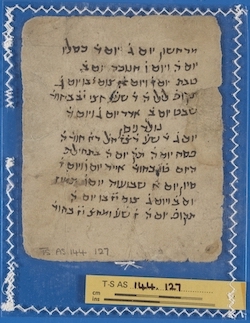
Estimated dating: second half 11th c.
Estimated starting cycle of the calendar: 254–256 (1047/8–1103/4 CE)
Dates covered: 1102/3–1103/4 CE. 19-year cycles covered: 256
Material: Paper
Language: Hebrew
Other calendars in the same hand: T-S Ar.29.128, T-S AS 144.59; T-S AS 144.23
T-S AS 144.23
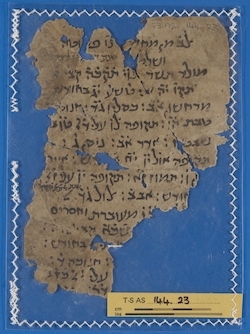
Estimated dating: second half 11th c.
Estimated starting cycle of the calendar: 254–256 (1047/8–1103/4 CE)
Dates covered: 1086/7–1089/90 CE. 19-year cycles covered: 256
Material: Paper
Language: Hebrew
Eras used: Creation
Other calendars in the same hand: T-S AS 144.127; T-S Ar.29.128, T-S AS 144.59
1050 CE
T-S NS 98.29
Estimated dating: second half 11th c.–first quarter 12th c.
Estimated starting cycle of the calendar: 255–257 (1066/7–1122/3 CE)
Dates covered: 1105/6–1107/8 CE 19-year cycles covered: 257
Material: Paper
Language: Hebrew
Eras used: Creation, Destructionof the Second Temple
Other calendars in the same hand: T-S AS 144.94
T-S Ar.29.124
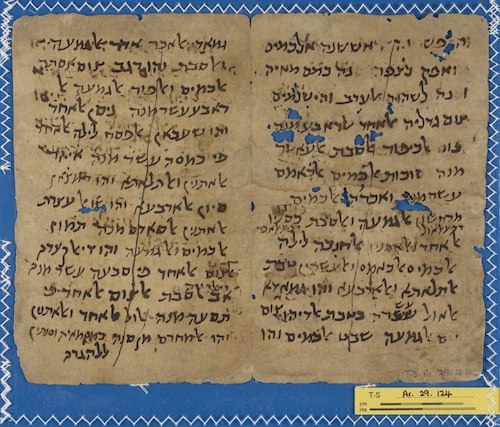
Estimated dating: second half 11th c. – first quarter 12th c.
Estimated starting cycle of the calendar: 255–257 (1066/7–1122/3 CE)
Dates covered: 1106/7–1108/9 CE. 19-year cycles: 257
Eras used: Seleucid, Hijra
Language: Judaeo-Arabic
Material: Paper
T-S K2.26
Estimated dating: second half 11th – first quarter 12th c.
Estimated starting cycle of the calendar: 255–257 (1066/7–1122/3 CE)
Dates covered: 1121/2–1122/3 CE. 19-year cycles: 257
Language: Hebrew
Material: Paper
Other calendars in the same hand: T-S NS 170.36a, AIU VIII.E.7
T-S Ar.29.123
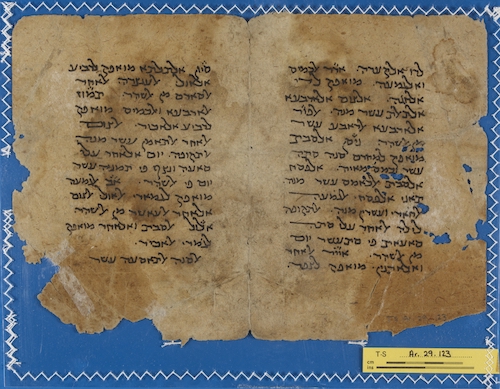
Estimated dating: second half 11th – first quarter 12th c.
Estimated starting cycle of the calendar: 255–257 (1066/7–1122/3 CE)
Dates covered: 1121/2–1122/3 CE. 19-year cycles: 257
Era used: Hijra
Language: Judaeo-Arabic
Material: Paper
T-S AS 154.31
Estimated dating: second half 11th c.–first quarter 12th c.
Estimated starting cycle of the calendar: 255–257 (1066/7–1122/3 CE)
Dates covered: 1108/9–1109/10 CE 19-year cycles covered: 257
Era used: Hijra
Material: Paper
Language: Judaeo-Arabic
Mosseri III.254.2
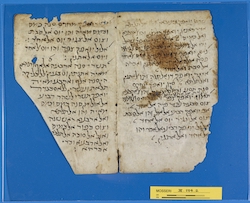
Estimated dating: second half 11th c.–first quarter 12th c.
Estimated starting cycle of the calendar: 255–257 (1066/7–1122/3 CE)
Dates covered: 1110/11–1111/12 CE, 1113/14–1114/15 CE. 19-year cycles covered: 257
Material: Parchment
Language: Judaeo-Arabic
Eras used: Creation, Seleucid, Hijra
Scribe, period and place of activity if known: Abraham b. Nathan, a rabbinic leader and judge in Cairo and Tyre, ca. 1037–1115 CE.
Location if known or can be estimated: Egypt/Palestine
T-S Ar.29.128, T-S AS 144.59
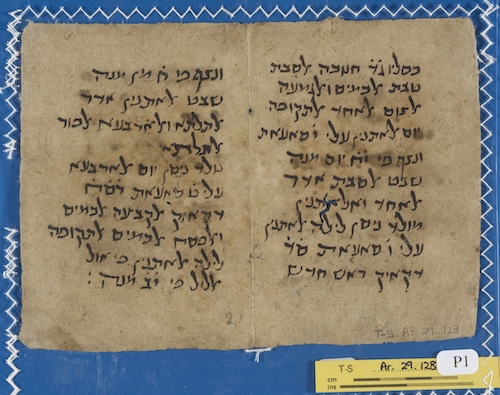
Estimated dating: second quarter 11th c. (see comment)
Estimated starting cycle of the calendar: 256 (1085/6–1103/4 CE)
Dates covered: 1087/8–1089/90 CE. 19-year cycles: 256
Era used: Creation
Language: Judaeo-Arabic
Material: Paper
Other calendars in the same hand: T-S AS 144.23; T-S AS 144.127
Comment: The ownership note on T-S AS 144.59v explains that the calendar covered only three years. The contents and layout of the calendar confirm this. The owner of the calendar was Yešuʿa b. Mivḥar known as bar Qišquš.
Or.1080 J76

Estimated dating: last quarter 11th. c. (see comment)
Estimated starting cycle of the calendar: 256 (1085/6–1103/4 CE)
Dates covered: 1088/9–1107/8 CE. 19-year cycles covered: 256–257
Material: Parchment
Language: Hebrew
Eras used: Creation
Comment: It appears that the calendar did not extend beyond the years covered in this fragment. The page before year 1088/9 CE is blank. In 1088/9 CE the 19-year cycle number is given, not provided in other years. In 1088/9–1090/91 CE calendar data is explained, in later years it is given without an explanation. This suggests that 1088/9 CE was the first year of this calendar.
T-S NS 98.14
Estimated dating: last quarter 11th c. (see comment)
Estimated starting cycle of the calendar: 256 (1085/6–1103/4 CE)
Dates covered: 1103/4 CE, 19-year cycles covered: 256
Material: Paper
Language: Judaeo-Arabic
Scribe, period and place of activity if known: Yaḵin the cantor b. Abraham, end 11th c.
Location if know or can be estimated: Egypt
Comment: Other documents associated with Yaḵin b. Abraham suggest that the calendar was copied in the 19-year cycle 256 (1085/6–1103/4 CE). Yaḵin b. Abraham signed a legal document dated 1092 CE (T-S 8J4.12) and a summary of his ketubba is dated 1094 CE (T-S 18J1.14).
T-S NS 157.136
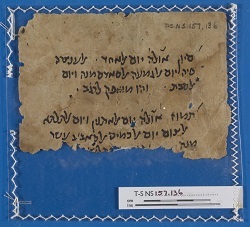
Estimated dating: last quarter 11th–mid 12th c. (see comment)
Estimated starting cycle of the calendar: 256–258 (1085/6–1141/2 CE)
Dates covered: 1132/3–1133/4 CE 19-year cycles covered: 258
Eras used: Creation, Seleucid, Destruction of the Second Temple
Material: Paper
Language: Judaeo-Arabic
Scribe, period and place of activity if known: Ḥalfon b. Manasseh, Fusṭāṭ, first half of the 12th c.
Location if known or can be estimated: Egypt
Other calendars in the same hand: T-S Ar.29.102, T-S K2.22, T-S K2.59
Comment: Documents in the hand of Ḥalfon b. Manasseh date from the year 1100 CE onwards.
T-S NS 170.36a, AIU VIII.E.7
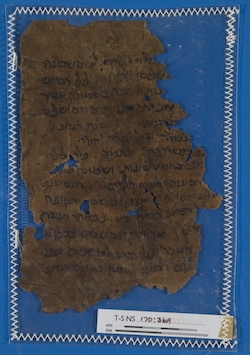
Estimated dating: last quarter 11th–mid 12th c.
Estimated starting cycle of the calendar: 256–258 (1085/6–1141/2 CE)
Dates covered: 1137/8–1138/9, 1140/1–1141/2 CE 19-year cycles covered: 258
Material: Paper
Language: Hebrew
Other calendars in the same hand: T-S K2.26
1100 CE
T-S AS 144.94
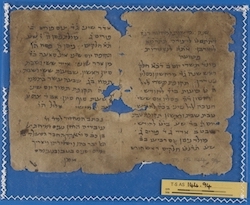
Estimated dating: first quarter 12th c. (see comment)
Estimated starting cycle of the calendar: 257 (1104/5–1122/3 CE)
Dates covered: 1108/9 CE, 1122/3 CE. 19-year cycles covered: 257
Material: Paper
Language: Hebrew
Eras used: Creation, Destruction of the Second Temple, Seleucid
Other calendars in the same hand: T-S NS 98.29
Comment: The calendar may have started in 1108/9 CE. The previous page (verso, left) is blank, suggesting that it was the cover page of the calendar booklet. The colophon at the end of 1122/3 CE (recto, left) states that the calendar was written for Obadiah the cantor b. Aaron he-Ḥaver. On the following page (verso, right), there is a birth record of Obadiah's son, who was born in 1108/9 CE. The calendar may have been prepared on the occasions of the birth. The birth record is in Obadiah's hand.
T-S Ar.29.34
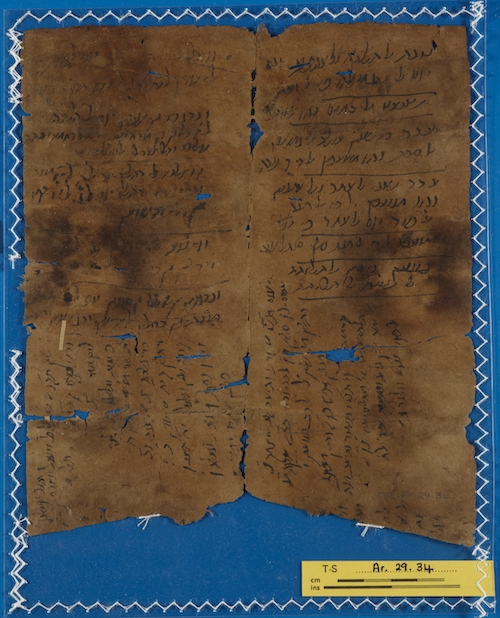
Estimated dating: first quarter 12th c. (see comment)
Estimated starting cycle of the calendar: 257 (1104/5–1122/3 CE)
Dates covered: 1118/9–1120/1 CE. 19-year cycles: 257
Language: Judaeo-Arabic
Material: Paper
Scribe: ʿAllān b. Ḥassūn, an India trader originally from the Maghreb, first quarter of the 12th c.
Location if known or can be estimated: India/Maghreb
Comment: It appears that the calendar did not extend beyond the years covered in this fragment. It starts with a title followed by an invocation (not found on other pages) at the top of year 1118/9 CE; year 1120/1 CE is incomplete and is followed by a personal account of ʿAllān b. Ḥassūn's travels in India.
T-S NS 259.96
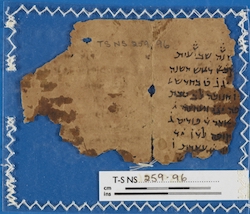
Estimated dating: first quarter 12th c. (see comment)
Estimated starting cycle of the calendar: 257 (1104/5–1122/3 CE)
Dates covered: 1121/2 CE, 1128/9-1129/30 CE. 19-year cycles covered: 257–258
Material: Paper
Language: Hebrew
Comment: It is likely that the calendar started in 1121/2 CE. The fragment is the outer bifolio of a quire and its first page (recto, left) is blank, suggesting that it is the cover page of the calendar booklet. This makes the year 1121/2 CE, on the following page, the first year covered by the calendar.
T-S Ar.29.102, T-S K2.22, T-S K2.59
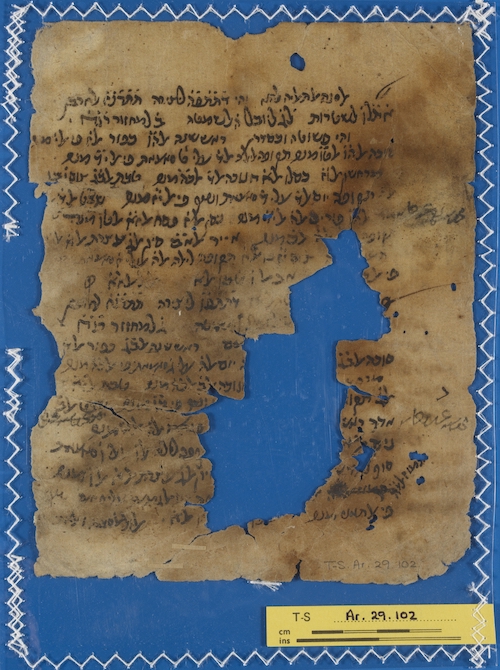
Estimated dating: first quarter 12th c.
Estimated starting cycle of the calendar: 257 (1104/5–1122/3 CE)
Dates covered: 1122/3–1129/30 CE, 1146/7–1149/50 CE. 19-year cycles: 257–259
Eras used: Creation, Seleucid, Destruction of the Second Temple, Hijra
Language: Judaeo-Arabic
Material: Paper
Location if known or can be estimated: Egypt
Scribe: Ḥalfon b. Manasseh, Fusṭāṭ, first half of the 12th c.
Other calendars in the same hand: T-S NS 157.136
T-S K2.44
Estimated dating: first half–mid 12th c.
Estimated starting cycle of the calendar: 257–259 (1104/5–1160/1 CE)
Dates covered: 1142/3 CE. 19-year cycles: 259
Eras used: Creation, Seleucid, Destruction of the Second Temple, Hijra
Language: Hebrew
Material: Paper
T-S NS 98.43, T-S NS 98.79, ENA 2857.45–46
Estimated dating: first half–mid 12th c.
Estimated starting cycle of the calendar: 257–259 (1104/5–1160/61 CE)
Dates covered: 1142/3–1143/4 CE, 1148/9–1149/50 CE, 1154/5–1155/6 CE 19-year cycles covered: 259
Material: Paper
Language: Judaeo-Arabic
Eras used: Creation, Seleucid, Destruction of the Second Temple
T-S Ar.29.139
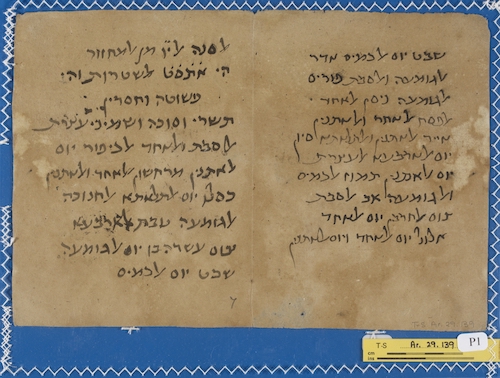
Estimated dating: first half-mid 12th c.
Estimated starting cycle of the calendar: 257–259 (1104/5–1160/1 CE)
Dates covered: 1151/2–1161/2 CE. 19-year cycles: 259
Era used: Seleucid
Language: Judaeo-Arabic
Material: Paper
T-S K2.31
Estimated dating: first half–mid 12th c.
Estimated starting cycle of the calendar: 257–259 (1104/5–1160/1 CE)
Dates covered: 1160/1 CE. 19-year cycles: 259
Language: Judaeo-Arabic
Material: Paper
T-S NS 98.11
Estimated dating: first half–mid 12th c.
Estimated starting cycle of the calendar: 257–259 (1104/5–1160/61 CE)
Dates covered: 1149/50 CE, 1152/3 CE. 19-year cycles covered: 259
Material: Paper
Language: Judaeo-Arabic
Comment: In the identified bifolio, calendar was copied only on the recto side of the pages and the verso sides were initially left blank.
T-S Ar.29.133, fols 2–3, T-S NS 313.16, ENA 3775.5, ENA 3775.6, T-S AS 157.368, Rylands B 6377
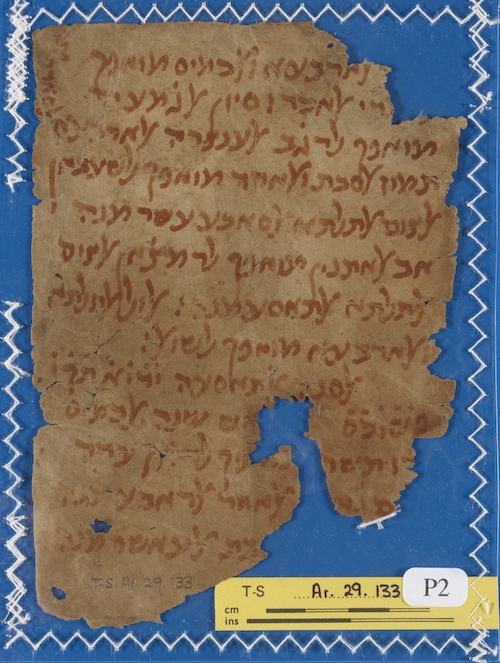
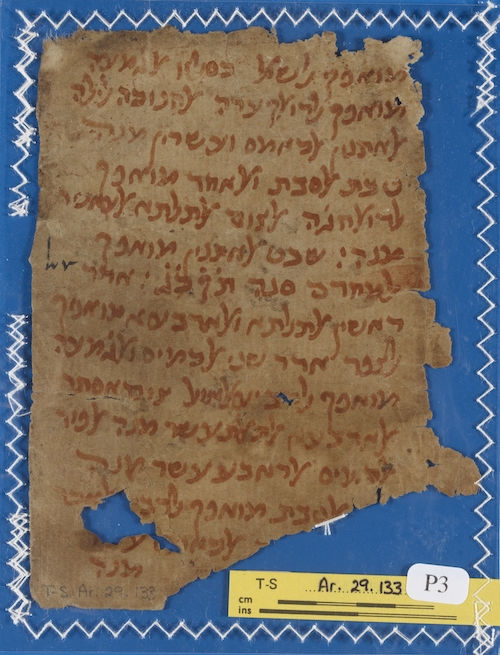
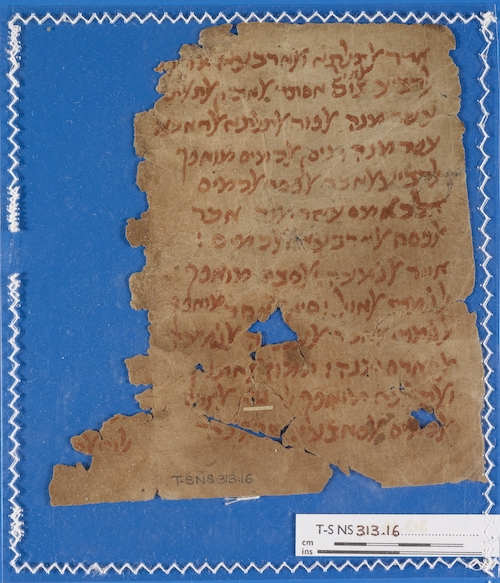
Estimated dating: second quarter 12th c. (see comment)
Estimated starting cycle of the calendar: 258 (1123/4–1141/2 CE)
Dates covered: 1127/8–1131/2 CE CE. 19-year cycles: 258
Era used: Hijra
Language: Judaeo-Arabic
Material: Paper
Comment: The calendar must have been copied in 1127/8 CE. The earliest surviving leaf of this calendar is ENA 3775.5. The recto of this folio is blank. On verso there is an invocation (not found on other pages), followed by the calendar for year 1127/8 CE, which is referred to as ‘our year’.
T-S NS 98.81
Estimated dating: second–third quarter 12th c.
Estimated starting cycle of the calendar: 258–260 (1123/4–1179/80 CE)
Dates covered: 1168/9–1071/2 CE 19-year cycles covered: 260
Material: Paper
Language: Judaeo-Arabic
Eras used: Hijra
T-S Ar.29.101r
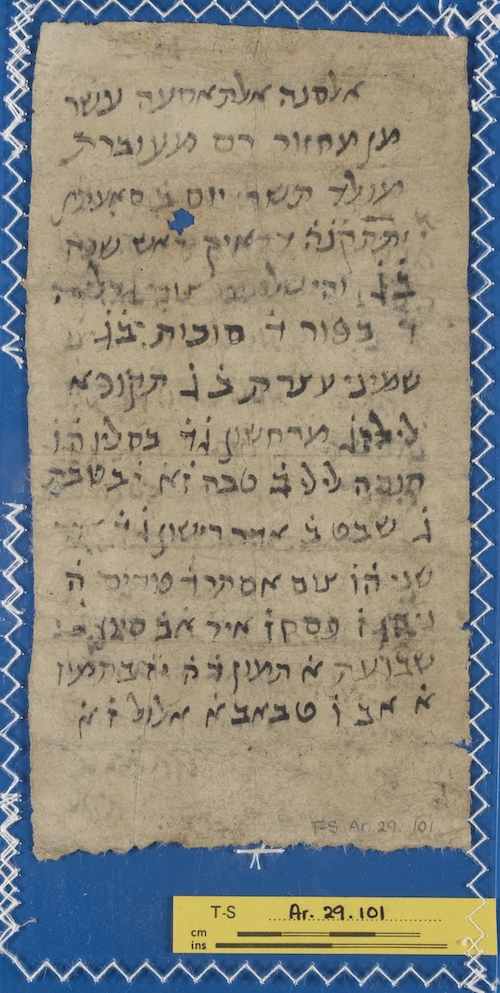
Estimated dating: second–third quarter 12th c.
Estimated starting cycle of the calendar: 258–260 (1123/4–1179/80 CE)
Dates covered: 1179/80 CE. 19-year cycles: 260
Material: Paper
Language: Judaeo-Arabic
T-S AS 159.222
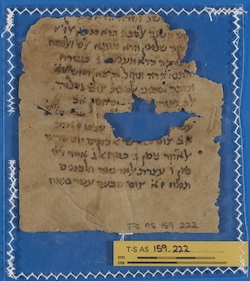
Estimated dating: second–third quarter 12th c.
Estimated starting cycle of the calendar: 258–260 (1123/4–1179/80 CE)
Dates covered: 1170/1–1171/2 CE. 19-year cycles covered: 260
Material: Paper
Language: Judaeo-Arabic
Era used: Hijra
T-S AS 144.50
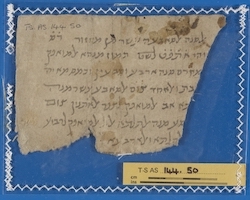
Estimated dating: second–third quarter 12th c. (see comment)
Estimated starting cycle of the calendar: 258–260 (1123/4–1179/80 CE)
Dates covered: 1177/8–1178/9 CE. 19-year cycles covered: 260
Material: Paper
Language: Judaeo-Arabic
Eras used: Seleucid, Hijra
Comment: The calendar for 1177/8 CE begins from Tammuz, which in that year corresponded to the first Muslim month, Muḥarram. It is possible that the calendar was copied in Tammuz 1177/8 CE.
T-S NS 220.10r, T-S NS 222.49
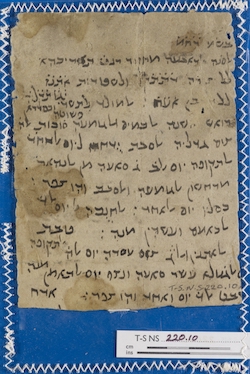
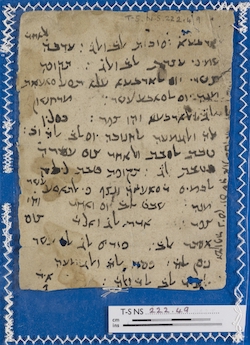
Estimated dating: mid 12th c. (see comment)
Estimated starting cycle of the calendar: 259 (1142/3–1160/61 CE)
Dates covered: 1145/6–1146/7 CE. 19-year cycles covered: 259
Eras used: Creation, Seleucid, Destruction of the Second Temple
Material: Paper
Language: Judaeo-Arabic
Comment: The calendar appears to have started in 1145/6 CE. The calendar for this year is copied at the back of a Mishna fragment and starts with an invocation not found on other pages.
T-S NS 156.37
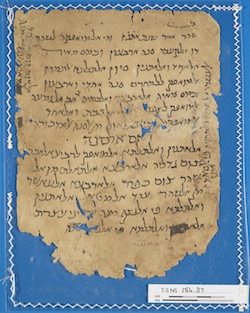
Estimated dating: mid 12th c. (see comment)
Estimated starting cycle of the calendar: 259 (1142/3–1160/61 CE)
Dates covered: 1145/6–1147/8 CE. 19-year cycles covered: 259
Eras used: Seleucid, Hijra
Material: Paper
Language: Judaeo-Arabic
Comment: The calendar may have started in Iyyar of 1145/6 CE. There is an invocation at the top of recto (not found on verso), followed by calendar data on the month of Iyyar of that year. In this month the Seleucid date is given, which is not found in any other month or in the following years.
T-S NS 98.13, NLI 577.6.16
Estimated dating: mid 12th c. (see comment)
Estimated starting cycle of the calendar: 259 (1142/3–1160/61 CE)
Dates covered: 1145/6–1150/51 CE. 19-year cycles covered: 259
Material: Paper
Language: Judaeo-Arabic
Eras used: Hijra
Comment: The calendar may have started in 1145/6 CE, year 4 of the 19-year cycle 259 and may have occupied the second half of the quire, preceded by some blank pages in the first half of the quire. In T-S NS 98.13 verso, right the calendar for 1145/6 CE is preceded by an invocation not found on other pages. The previous page (T-S NS 98.13 recto, left) is blank, and the bifolio is continuous, making it the middle bifolio of the quire. Folio 1 recto of NLI 577.6.16 directly follows T-S NS 98.13 recto, right, making NLI 577.6.16 the second bifolio counting from the middle of the quire. Folio 2 of NLI 577.6.16, which originally belonged to the first part of the quire, is blank.
T-S 24.66v bottom
Estimated dating: mid 12th c. (see comment)
Estimated starting cycle of the calendar: 259 (1142/3–1160/61 CE)
Dates covered: 1146/7–1148/9 CE. 19-year cycles: 259
Eras used: Seleucid, Hijra
Language: Judaeo-Arabic
Material: Paper
Scribe: Abraham b. Yijū, an India trader originally from the Maghreb, second quarter–mid 12th c.
Other calendars in the same hand: T-S 12.320 verso, top; T-S 10K20.1
Comment: The calendar is included at the bottom of a letter to Abraham b. Yijū that concerns business in Aden in 1133–1140 CE. The year 1146/7 CE, placed directly at the bottom of the letter, is the starting year of the calendar.
T-S 10K20.1
Estimated dating: mid 12th c. (see comment)
Estimated starting cycle of the calendar: 259 (1142/3–1160/61 CE)
Dates covered: 1153/4–1155/6 CE. 19-year cycles covered: 259
Eras used: Creation, Seleucid, Destruction of the Second Temple, Hijra
Material: Paper
Language: Judaeo-Arabic
Scribe, period and place of activity if known: Abraham b. Yijū, an India trader originally from the Maghreb, second quarter–mid 12th c.
Location if known or can be estimated: India/Maghreb
Comment: The calendar appears to have started in 1153/4 CE. The folio before this year is blank and must have formed the cover page of the booklet.
T-S NS 152.155
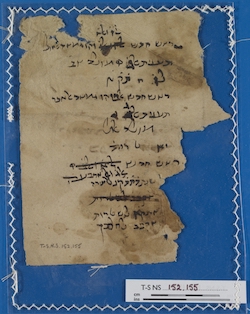
Estimated dating: mid–second half 12th c.
Estimated starting cycle of the calendar: 259–261 (1142/3–1198/9 CE)
Dates covered: 1188/9–1189/90 CE. 19-year cycles covered: 261
Eras used: Creation, Seleucid, Destruction of the Second Temple
Material: Paper
Language: Judaeo-Arabic
1150 CE
Or.1080 1.74, ENA NS 63.18
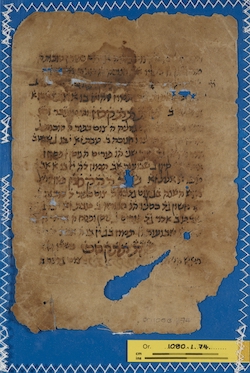
Estimated dating: mid 12th c. (see comment)
Estimated starting cycle of the calendar: 260 (1161/2–1179/80)
Dates covered: 1161/2–1164/5 CE, 1202/3–1208/9 CE 1214/5–1217/8 CE. 19-year cycles covered: 260–262
Material: Paper
Language: Hebrew; Judaeo-Arabic
Eras used: Creation (main text); Seleucid Era and Hijra (secondary note)
Location if known or can be estimated: Egypt
Comment: According to the colophon in ENA NS 63.18 verso, the calendar was copied in Tammuz 4926 of the Era of Creation (= 1166 CE) in Fusṭāṭ.
T-S K2.20, T-S NS 98.105, T-S NS 152.159
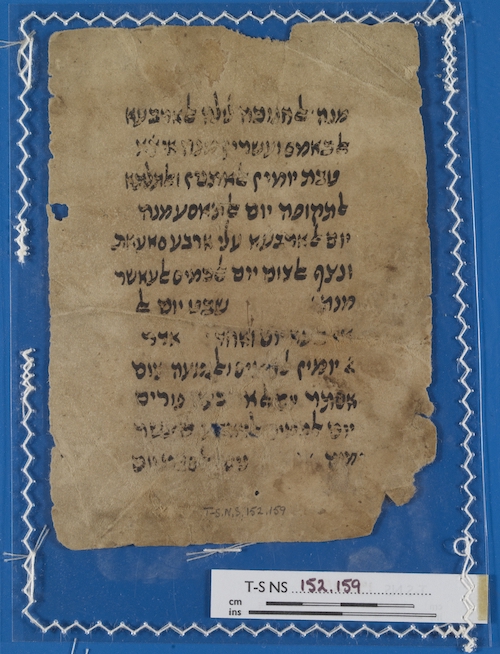
Estimated dating: second half 12th c. – first quarter 13th c.
Estimated starting cycle of the calendar: 260–262 (1161/2–1217/8 CE)
Dates covered: 1202/3–1205/6 CE. 19-year cycles: 262
Language: Judaeo-Arabic
Material: Paper
T-S NS 38.29
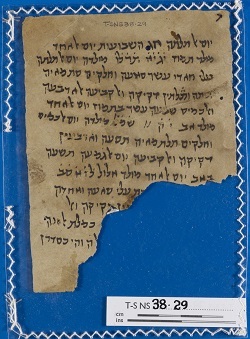
Estimated dating: second half 12th c.– first quarter 13th c.
Estimated starting cycle of the calendar: 260–262 (1161/2–1217/8 CE)
Dates covered: 1199/1200–1200/1 CE. 19-year cycles covered: 262
Eras used: Creation, Seleucid
Material: Paper
Language: Judaeo-Arabic
T-S NS 98.26, T-S NS 98.27, BL Or 5565B.31–35, ENA 2559.8
Estimated dating: second half 12th c.– first quarter 13th c.
Estimated starting cycle of the calendar: 260–262 (1161/2–1217/8 CE)
Dates covered: 1206/7–1211/2 CE 19-year cycles covered: 262
Material: Paper
Language: Judaeo-Arabic
Eras used: Creation, Selecid, Destruction of the Second Temple, Hijra
L-G Misc.61
Estimated dating: second half 12th c.– first quarter 13th c.
Estimated starting cycle of the calendar: 260–262 (1161/2–1217/8 CE)
Dates covered: 1201/2–1203/4 CE 19-year cycles covered: 262
Material: Paper
Language: Judaeo-Arabic
Eras used: Creation, Seleucid, Destruction of the Second Temple
Other calendars in the same hand: T-S NS 98.90, T-S NS 98.6; ENA 4061.1
T-S NS 98.6, T-S NS 98.90
Estimated dating: second half 12th c.– first quarter 13th c.
Estimated starting cycle of the calendar: 260–262 (1161/2–1217/8 CE)
Dates covered: 1208/9–1209/10 CE, 1216/7 CE. 19-year cycles covered: 262
Material: Paper
Language: Judaeo-Arabic
Eras used: Destruction (in a secondary hand in T-S NS 98.6)
Other calendars in the same hand: L-G Misc. 61; ENA 4061.1
T-S K2.111, T-S NS 325.202, Mosseri IV.70.1
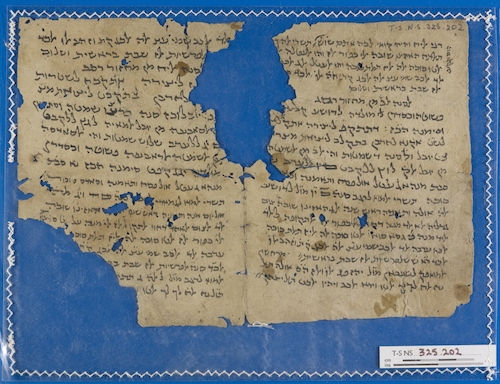
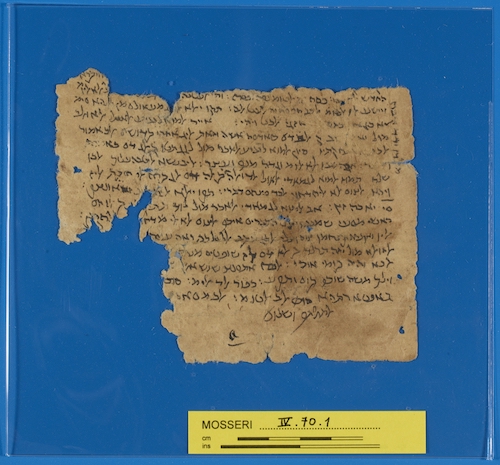
Estimated dating: last quarter 12th c. – first half 13th c.
Estimated starting cycle of the calendar: 261–263 (1180/1–1236/7 CE)
Dates covered: 1215/6–1216/7, 1218/9–1219/20, 1222/3 CE. 19-year cycles: 262–263
Eras used: Creation, Seleucid, Destruction of the Second Temple, Exodus, Hijra, Coptic
Language: Judaeo-Arabic
Material: Paper
Location if known or can be estimated: Egypt
Scribe: Yedutun ha-Levi, Fusṭāṭ, first quarter of the 13th c.
Other calendars in the same hand: T-S NS 98.82; T-S K2.33, ENA 3740.11, ENA 3740.12, AIU VIII.E.23, Bodl. MS Heb. f. 102.32–35
T-S NS 98.82
Estimated dating: last quarter 12th c. – first half 13th c.
Estimated starting cycle of the calendar: 261–263 (1180/1–1236/7 CE)
Dates covered: 1217/8–1218/9 CE. 19-year cycles: 262–263
Language: Judaeo-Arabic
Material: Paper
Location if known or can be estimated: Egypt
Scribe: Yedutun ha-Levi, Fusṭāṭ, first quarter of the 13th c.
Other calendars in the same hand: T-S K2.111, T-S NS 325.202, Mosseri IV.70.1; T-S K2.33, ENA 3740.11, ENA 3740.12, AIU VIII.E.23, Bodl. MS Heb. f. 102.32–35
T-S K2.33, ENA 3740.11, ENA 3740.12, AIU VIII.E.23, Bodl. MS Heb. f. 102.32–35
Estimated dating: last quarter 12th c. – first half 13th c.
Estimated starting cycle of the calendar: 261–263 (1180/1–1236/7 CE)
Dates covered: 1223/4 CE, 1226/7 CE, 1233/4–1234/5 CE. 19-year cycles: 263
Eras used: Creation, Exodus, Seleucid, Destruction of the Second Temple, Hijra, Coptic
Language: Judaeo-Arabic
Material: Paper
Location if known or can be estimated: Egypt
Scribe: Yedutun ha-Levi, Fusṭāṭ, first quarter of the 13th c.
Other calendars in the same hand: T-S NS 98.82; T-S K2.111, T-S NS 325.202, Mosseri IV.70.1
T-S Ar.29.184, ENA 2715.32
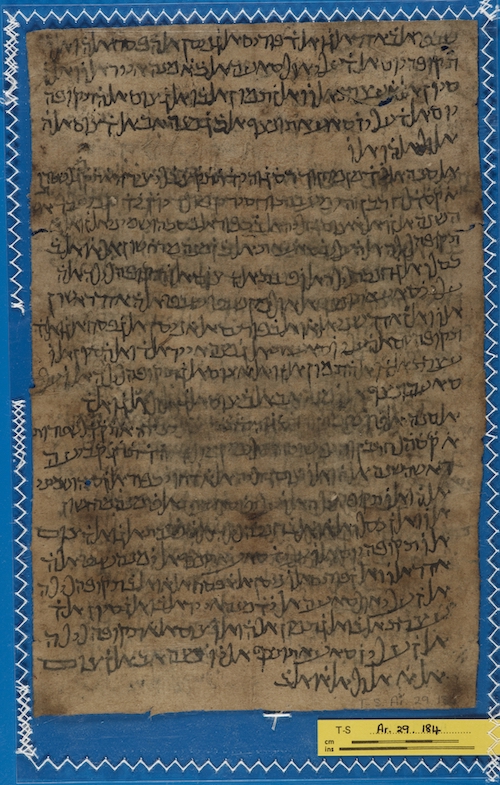
Estimated dating: last quarter 12th c. – first half 13th c.
Estimated starting cycle of the calendar: 261–263 (1180/1–1236/7 CE)
Dates covered: 1218/9–1232/3 CE. 19-year cycles: 263
Eras used: Creation, Seleucid, Destruction of the Second Temple
Language: Judaeo-Arabic
Material: Paper
T-S K2.43
Estimated dating: last quarter 12th c. – first half 13th c.
Estimated starting cycle of the calendar: 261–263 (1180/1–1236/7 CE)
Dates covered: 1229/30 CE. 19-year cycles: 263
Eras used: Seleucid, Hijra
Language: Judaeo-Arabic
Material: Paper
T-S K2.48
Estimated dating: last quarter 12th c. – first half 13th c.
Estimated starting cycle of the calendar: 261–263 (1180/1–1236/7 CE)
Dates covered: 1229/30 CE. 19-year cycles: 263
Eras used: Creation, Seleucid, Destruction of the Second Temple
Language: Judaeo-Arabic
Material: Paper
Other calendars in the same hand: T-S K2.91, L-G Misc.54
Comment: Calendars in this hand are written only on one side of the page and the other side is used for calculations and other related information.
T-S Ar.29.42, T-S Ar.29.71
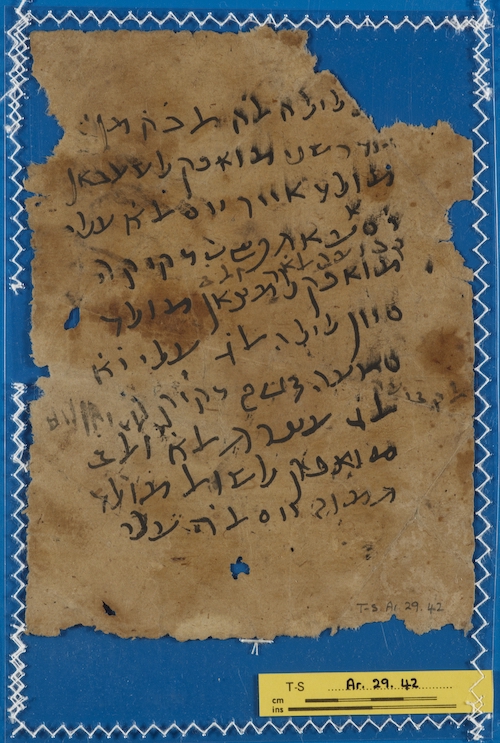
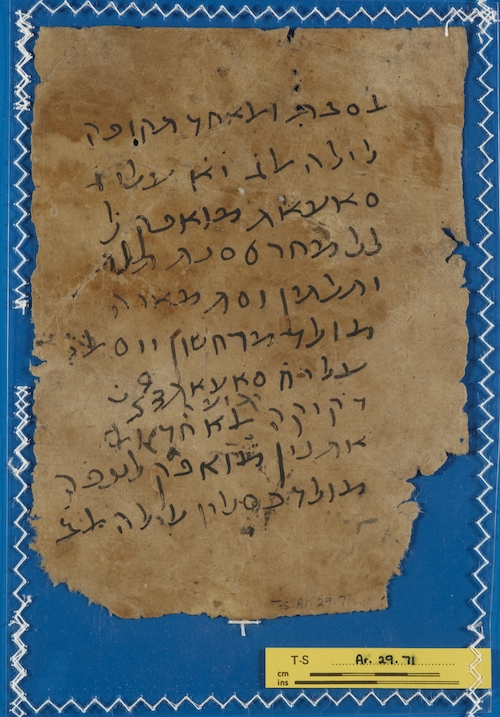
Estimated dating: last quarter 12th c. – first half 13th c.
Estimated starting cycle of the calendar: 261–263 (1180/1–1236/7 CE)
Dates covered: 1235/6–1236/7 CE. 19-year cycles: 263
Eras used: Creation, Seleucid, Hijra
Language: Judaeo-Arabic
Material: Paper
T-S AS 144.10, T-S AS 144.92, T-S AS 144.246v
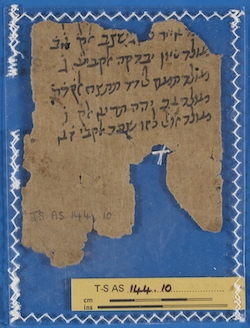
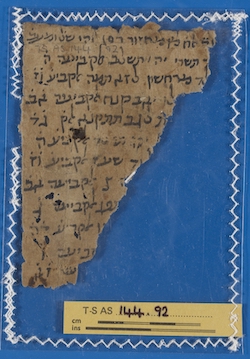
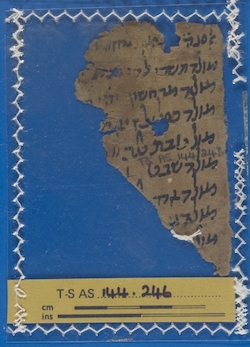
Estimated dating: last quarter 12th c.–first half 13th c.
Estimated starting cycle of the calendar: 261–263 (1180/1–1236/7 CE)
Dates covered: 1225/6–1226/7CE. 19-year cycles covered: 263
Material: Paper
Language: Judaeo-Arabic
1200 CE
T-S 28.11r
Estimated dating: first quarter 13th c. (see comment)
Estimated starting cycle of the calendar: 262 (1199/1200–1217/8 CE)
Dates covered: 1207/8–1211/12 CE. 19-year cycles covered: 262
Eras used: Hijra
Material: Paper
Language: Judaeo- Arabic
Comment: The calendar is copied at the back of a letter dated 1202 CE. It appears that the calendar did not extend beyond the years covered in the fragment.
T-S NS 98.7
Estimated dating: first quarter 13th c. (see comment)
Estimated starting cycle of the calendar: 262 (1199/1200–1217/8 CE)
Dates covered: 1199/1200 CE. 19-year cycles covered: 262
Material: Paper
Language: Hebrew
Eras used: Creation, Seleucid, Destruction of the Second Temple
Comment: The calendar may have started in 1199/1200 CE, the first year of the 19-year cycle 262. The page before it is blank (now verso), suggesting that it was the cover page of the calendar booklet.
T-S K2.72, T-S Ar.29.171
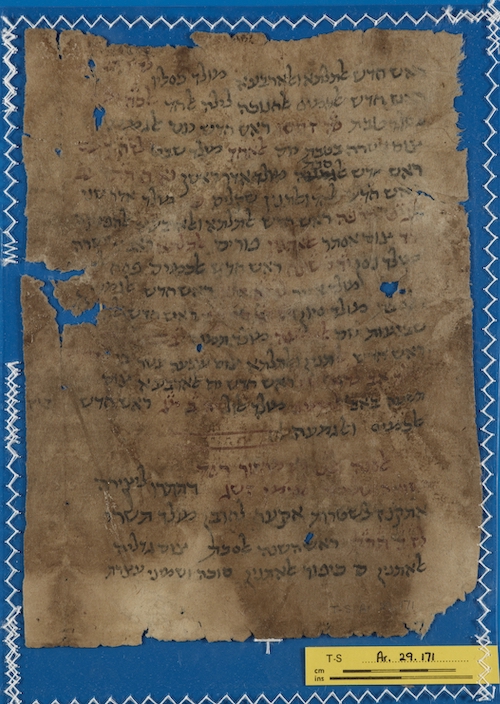
Estimated dating: first half 13th c.
Estimated starting cycle of the calendar: 262–264 (1199/1200–1255/6 CE)
Dates covered: 1242/3–1245/6 CE. 19-year cycles: 264
Eras used: Creation, Seleucid, Destruction of the Second Temple
Language: Judaeo-Arabic
Material: Paper
T-S K2.91, L-G Misc.54
Estimated dating: first half 13th c.
Estimated starting cycle of the calendar: 262–264 (1199/1200–1255/6 CE)
Dates covered: 1246/7–1247/8 CE. 19-year cycles: 264
Eras used: Creation, Seleucid, Destruction of the Second Temple, Exodus
Language: Judaeo-Arabic
Material: Paper
Other calendars in the same hand: T-S K2.48
Comment: Calendars in this hand are written only on one side of the page and the other side is used for calculations and other related information.
T-S K2.38, T-S Ar.2.5
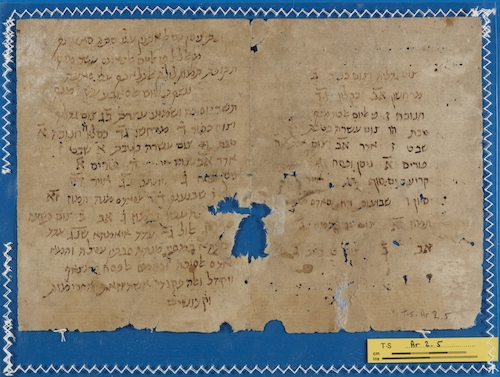
Estimated dating: first half 13th c.
Estimated starting cycle of the calendar: 262–264 (1199/1200–1255/6 CE)
Dates covered: 1248/9 CE, 1251/2–1252/3 CE. 19-year cycles: 264
Eras used: Creation, Seleucid, Destruction of the Second Temple, Hijra
Language: Judaeo-Arabic
Material: Paper
T-S Ar.29.133, fol. 1
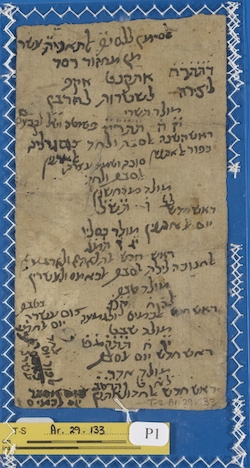
Estimated dating: first half 13th c.
Estimated starting cycle of the calendar: 262–264 (1199/1200–1255/6 CE)
Dates covered: 1248/9 CE (see comment) 19-year cycles: 264
Eras used: Creation, Seleucid, Destruction of the Second Temple
Language: Judaeo-Arabic
Material: Paper
Comments: The calendar is dated 5008 of the Era of Creation, 1559 of the Seleucid Era, 1180 of the Era of the Destruction of the Second Temple, year 11 of the 19-year cycle 264. These dates align, but the provided calendar is for the following year, 5009 of the Era of Creation (= 1248/9 CE). This mistake was rectified in the manuscript by writing “year 12” of the 19-year cycle over “year 11”.
T-S AS 143.37
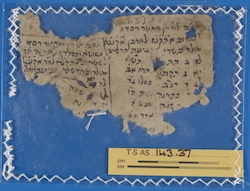
Estimated dating: first half 13th c.
Estimated starting cycle of the calendar: 262–264 (1199/1200–1255/6 CE)
Dates covered: 1245/6–1248/9 CE. 19-year cycles covered: 264
Eras used: Creation, Seleucid, Destruction of the Second Temple
Material: Paper
Language: Judaeo-Arabic
T-S AS 144.282
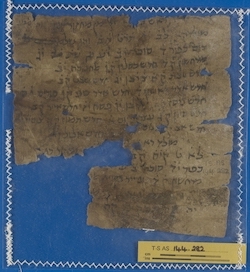
Estimated dating: first half 13th c.
Estimated starting cycle of the calendar: 262–264 (1199/1200–1255/6 CE)
Dates covered: 1250/51–1251/2 CE 19-year cycles covered: 264
Material: Paper
Language: Hebrew
T-S AS 149.101
Estimated dating: first half 13th c.
Estimated starting cycle of the calendar: 263–264 (1218/9–1255/6 CE)
Dates covered: 1254/5–1257/8 CE. 19-year cycles covered: 264-265
Eras used: Seleucid, Destruction of the Second Temple
Material: Paper
Language: Judaeo-Arabic
T-S AS 144.252
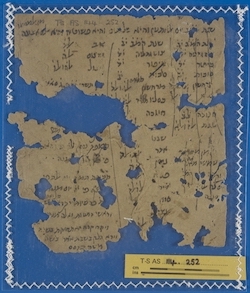
Estimated dating: second–fourth quarter 13th c.
Estimated starting cycle of the calendar: 264–266 (1237/8–1293/4 CE)
Dates covered: 1281/2–1283/4 CE. 19-year cycles covered: 266
Language: Judaeo-Arabic
Material: Paper
Eras used: Creation
1250 CE
T-S NS 98.20, BL Or. 10655.14
Estimated dating: second half 13th c. – early 14th c.
Estimated starting cycle of the calendar: 265–267 (1256/7–1312/3 CE)
Dates covered: 1297/8, 1310/11–1311/12 CE. 19-year cycles: 267
Eras used: Creation, Seleucid, Destruction of the Second Temple
Language: Judaeo-Arabic
Material: Paper
Location if known or can be estimated: Egypt
Scribe: Solomon b. Saʿadya, Fusṭāṭ, late 13th c.
Other calendars in the same hand: T-S K2.14
T-S K2.14
Estimated dating: second half 13th c. – early 14th c.
Estimated starting cycle of the calendar: 265–267 (1256/7–1312/3 CE)
Dates covered: 1303/4–1304/5 CE. 19-year cycles: 267
Language: Judaeo-Arabic
Material: Paper
Location if known or can be estimated: Egypt
Scribe: Solomon b. Saʿadya, Fusṭāṭ, late 13th c.
Other calendars in the same hand: T-S NS 98.20, BL Or. 10655.14
T-S NS 98.59
Estimated dating: second half 13th c.– early 14th c.
Estimated starting cycle of the calendar: 265–267 (1256/7–1312/3 CE)
Dates covered: 1298/9 CE, 1301/2 CE 19-year cycles covered: 267
Material: Paper
Language: Judaeo-Arabic
Eras used: Creation, Seleucid
T-S K2.80
Estimated dating: last quarter 13th c. – first half 14th c.
Estimated starting cycle of the calendar: 266–268 (1275/6–1331/2 CE)
Dates covered: 1315/6–1320/1 CE. 19-year cycles: 268
Language: Judaeo-Arabic
Material: Paper
Explanation of the Eras
The epoch of the Creation Era is generally Tishri 3761 BCE. In medieval Hebrew manuscripts from Iran, Kurdistan and other Eastern regions the epoch is Tishri 3760 BCE.
The Seleucid Era takes as its epoch Tishri 312 BCE.
The Era of the Destruction of the Second Temple takes as its epoch Tishri 67 CE.
The Era of the Exodus takes as its epoch Tishri 1313 BCE.
The Era of the Hijra takes as its epoch July 622 CE.
The Coptic Era takes as its epoch August 284 CE.
The Byzantine Era takes as its epoch September 5509 BCE.

